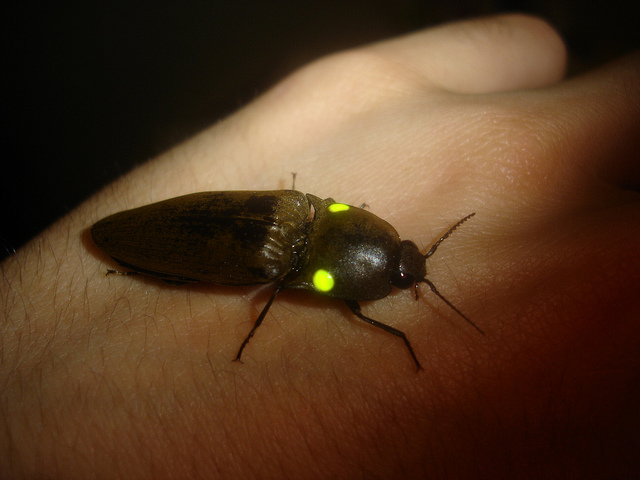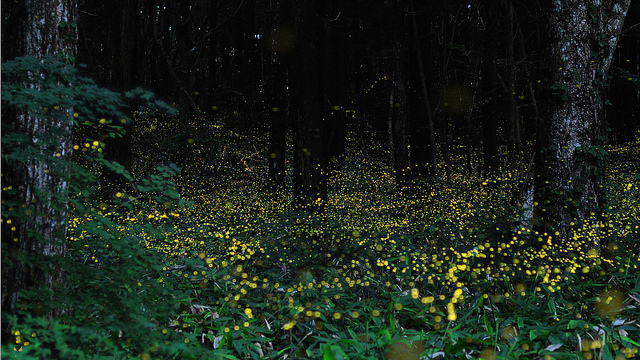Our first or only experience of glowing animals is probably being allured by the dazzling light show put on by fireflies. The seemingly magical ability to emit your own light – a phenomenon called bioluminescence – is actually produced by a chemical reaction inside the organism. The reaction involves an enzyme known as luciferase, a molecule called luciferin, and a molecule of oxygen. Luciferase acts upon the reaction between luciferin and oxygen to give a new compound generating the light that we see. This process requires energy but bioluminescence is amazingly efficient: less than 20 percent of the light is wasted as heat and for this reason it is often referred to as “cold light”.
While bioluminescence is widespread among marine organisms, it’s rare on land, and evolved millions of years later. Nevertheless, there are some fascinating land creatures that have evolved the ability to produce light – mostly insects and fungi. Though the light emitted can come in different colors, the most common colors both in the sea and on land are blue and green but on land you can also see rare instances of yellow and even red. Organisms glow for various reasons like attracting mates, warning predators, and finding food. Some glow only at specific times, for a few seconds only, while others glow constantly. Here are some of the few mesmerizing land creatures capable of glowing. How many of these have you spotted before?
1. Glittering Glowworms: A fatal attraction

The bioluminescent glowworms Arachnocampa luminosa, also known as fungus gnats, are about the size of a matchstick and found only in the dark and damp areas of New Zealand, particularly the Waitomo Caves, which have become a popular tourist attraction for its stunning starry spectacle. These glowworms are the larvae that hatch out of eggs and eventually become adult two-winged insects that usually live only for a few days solely for the purpose of mating. During the larval stage, which is the longest stage lasting up to 9 months, the larvae have to eat voraciously to last until the adult stage during which they cannot eat as they do not have mouths.
These cave-dwellers have devised a devious tactic to trap their prey: They construct their own “fishing lines” made of silk with sticky mucous droplets that they can hang down from the ceiling; these lines can extend as long as 20 inches in length. As night descends, they glow a radiant blue color to lure unsuspecting prey such as insects – either crawling or flying towards the decoy – that become ensnared in the sticky mesh of lines and paralyzed by chemicals in the mucus. The larvae then creep down and eat their catch. The hungrier they are, the brighter they can glow. Surprisingly, they take only 15 minutes to make one line and can make up to 25 lines a night!

They are extremely territorial and when their densities are high, they can even resort to cannibalism if they sense an invader of their own species. Adult females illuminate to attract mates, though males can glow too, and when several males arrive they fight each other until the fittest one wins the female. The female loses its ability to glow after laying eggs.
If you happen to be lucky to see these amazing creatures, stay silent and don’t shine flashlights on them because they will turn their lights off.
2. Shiny Snails

The snail, Quantula striata, may look just like any other snail but it is the only land snail known to be capable of producing light, and is found in Southeast Asia. Unusually, its eggs continuously glow in the dark and upon hatching they produce momentary flashes of yellow-green light from behind their mouth for several days, though the light is dim.
The reasons for glowing and flashing are a mystery but interestingly they stop glowing upon reaching reproductive maturity. Some researchers suggested that through flashing they communicate with other members of their species and can congregate, though they are not sure why. What a creative way to invite others for a get-together!
3. Flashy Fungus

Apart from insects, bioluminescence is most common among fungi; in fact at least 50 species of luminous mushrooms have been reported, with Australian species being more luminous than North American ones. One of the coolest species is a mushroom Mycena lucentipes, one of six bioluminescent mushroom species that scientists discovered in 2006 in the Atlantic forest of Brazil. It glows bright green and at night it is truly an enthralling sight. But why do they glow? Mycologists or fungi experts don’t know but they have speculated that it may be to beckon arthropods that help in dispersing their spores to other locations. Other explanations posited that their glow may deter bugs from eating them or attract predators of the bugs to eat them so that they cannot eat the fungi – in other words they may invite their enemy’s enemy to protect themselves.
There are more fungi species out there waiting to be discovered so next time you go for a walk in the forest, go at night and look around carefully – who knows you might even stumble upon a new glowing fungus!
4. Toxic Glow-in-the-Dark Millipedes

Of the over 12,000 millipede species known, only a handful of them belonging to the genus Motyxia are bioluminescent and all of them are found exclusively in the mountainous regions of California. They spend the day burrowed under the soil but upon nightfall these blind creepy crawlies wriggle out from the ground to munch on dead plants and emit a constant glow from their exoskeleton. Their glow is ominous to predators: When disturbed or threatened they release toxic cyanide from tiny pores in their bodies. In an experiment to test this notion, researchers placed fake painted millipedes made of clay alongside real glowing ones at night and examined them the next morning. To their surprise the fake millipedes were viciously attacked upon four times more often than the real glowing ones by what they deduced were rodents.
Amazingly , these millipedes have evolved a different mechanism to glow that doesn’t use luciferase but employs a photoprotein instead that lights up when activated with calcium-rich compounds. This mechanism is similar to the way the jellyfish, Aequorea Victoria, glow using green fluorescent protein, which is widely used in the lab for research purposes such as attaching it to genes of interest to study their location inside cells.
5. Radiant Railroad Worms

Railroad worms are larvae and female larviforms, which are adults – about two inches in length – that resemble larvae and belong to the same beetle superfamily as fireflies. They are one of the few organisms that achieve the remarkable feat of emitting not one but two colors in different parts of their body. These worms belong to the genus Phrixothrix and are found in South America. The worms resemble a miniature train bustling away at night: The head glows a fiery red whereas the body emits green light through eleven pairs of luminous spots arranged in rows.
Scientists learned that the luciferase enzyme involved in the reaction that gives off the atypical red color in the head is the only enzyme that can do this in nature and is slightly different in structure from other luciferases. Studies as far back as the 1940s reported that upon a slight disturbance – such as knocking the table and blowing over them – they switch on their red headlight and when faced with more vigorous disturbances they turn on both of their rows of green lights. More recent evidence suggests that their glow sends a signal to predators that they taste terrible.
6. Luminous Click Beetles

Many click beetles in the family Elateridae (close relatives of fireflies) especially those from the genus Pyrophorus are bioluminescent and they are found in tropical areas of the Western hemisphere. They are also called snapping beetles and as their name suggests, they make clicking sounds when propelling themselves up in the air – often several inches – to right themselves if they are lying upside down. When threatened by predators they can also swiftly jump high up in the air to defend themselves.
What’s more, they produce a constant light in many different colors – from green all the way to orange depending on the species – in two spots in the front looking like headlights and one below its abdomen. The headlights glow so intensely that they can be spotted over a hundred feet away. The Jamaican species Pyrophorus plagiophthalamus is unique in that it can produce two different colors of light in its body; underneath its body it emits a yellow light and on the top its headlights glow green. They sure look like they’re from another planet. Scientists think that their upper and lower lights have different functions: their headlights are a beacon to predators of their toxicity while the light under their bellies facilitates communication between members of the opposite sex.
7. Freaky Glowing Cockroach

As if roaches weren’t creepy enough, how about encountering the glowing roach, Lucihormetica lucka, scurrying outside your home at night? Well chances are rare – in fact you may never encounter one in your life because they’re only found in the rainforests near an active volcano in Ecuador and the last known specimen was collected in 1939. Chances are that they may even be extinct by now.
But glowing roaches aren’t new: since their first discovery in 1999, 13 species have been identified in South America. L. lucka’s two eye-like spots and another spot on its back illuminate broadcasting their toxicity. But it turns out they are not really toxic – they’re just faking it; they’re cleverly mimicking click beetles – their older relatives mentioned earlier – that glow to advertize their toxicity but this roach that emits a light identical in color is just fooling its predators. Looks can truly be deceiving! The light spots are filled with bacteria that live on its exoskeleton.
8. Eerie Earthworms

We’ve all seen earthworms at some point in our lives. But have you have ever seen a glowing earthworm? There are 33 species of luminescent earthworms found all around world though most of them are clustered in the American South. They emit light from blue all the way till the red end of the spectrum.
Earthworms normally secrete mucus, which scientists call coelemic fluid, to glide easily in their burrows, but a couple of rare species exude a unique type of mucus – one that can actually glow. Yes, you heard right, its mucus is bioluminescent!
There are two species reported with different colors of slime: one from New Zealand and the other from Georgia in the US. The peculiar earthworm in New Zealand, Octochaetus multiporus, oozes a bright glow-in-the-dark orange-yellow coelemic fluid from its mouth, anus, and underside when it feels disturbed or threatened. In fact, it is so bizarre that its fluid seems to glow in different colors at different stages of its life. Interestingly, their glowing slime was spotted by the Maori who exploited O. multiporus as fishing baits. The earthworm from Georgia, Diplocardia longa, is found in the sandy soils of the coastal plains and spews a brilliant blue slime that is thought to alarm predators. Perhaps the colored slime oozing from monsters that we see in children’s games isn’t that far-fetched after all.
9. Beaming Bacteria: A friend or a foe?

Photorhabdus luminescens are incredibly unique in that they are the only land bacteria capable of bioluminescence. They are fascinating because on the one hand they are useful to nematode worms (roundworms) but on the other hand they are lethal to other bugs. The microbes live happily in the guts of soil-dwelling nematode worms in a symbiotic alliance where both of them benefit: They impart a soft blue glow to the worms, presumably to entice prey, and in turn they share some of the nutrients from the worm’s food.
To make things complicated, these nematodes are actually parasites that hunt other soil insects – such as the larvae of beetles, moths, and flies – where they penetrate into and establish themselves inside their body. Once inside, they regurgitate their insidious microbial partners into the host’s bloodstream. The microbes then begin their chemical warfare; they kill the host by injecting a flood of deadly insecticidal proteins into its cells and enzymes that break down its body, reducing it to a “nutrient soup” within two days. P. luminescens happily devours this soup and multiplies exponentially giving rise to millions more of itself. At the same time, the microbes release antibiotics preventing other bacteria from invading their feast. The worm in turn feeds on the thriving bacteria and undergoes several rounds of reproduction inside the cadaver producing hundreds of eggs each time that also consume the bacteria. When nutrient supplies dwindle, the remaining bacteria re-colonize the guts of the worm’s newly hatched offspring and they erupt from the corpse to set off seeking their next victim. Sometimes when food supplies are exceedingly low, the hatched offspring feed on their mother’s gut instead, killing her in a gruesome phenomenon called matricida endotokia.

Thousands of nematodes bursting from a moth cadaver.
While P. luminescens are lethal to insects, they are harmless to humans. In fact, their antibiotic-producing capacities proved to be a boon to injured soldiers in the battlefield during the Civil War in 1862 – a pre-antibiotic era. Apparently some wounded soldiers, especially those who waited out in the cold rain for help, from the Battle of Shiloh seemed to survive better and faster than others; it turned out they had wounds that literally glowed-in-the-dark – a phenomenon that became known as the “Angel’s Glow”. It is now thought that their wounds were colonized by P. luminescens from the muddy soil that protected them from infection by other deadly bacteria. Well in some rare cases, some bacterial infections on wounds may actually be helpful – especially those that glow!
Scientists are investigating using this deadly pair as a biological insecticide on crops to protect them from infestation by bugs.
10. Flamboyant Fireflies – Nature’s free fireworks display

We cannot complete our list without covering fireflies – the most popular and widely studied bioluminescent land organisms. Fireflies are actually beetles whose conversations consist of patterns of light flashes from their abdomens, which are unique to each species, and can be yellow, green, or even red. Male fireflies exhibit specific light flashes that are only understood by potential mates who respond by emitting the same flashing signal that males can recognize and move towards the females. Sound like a charming way to attract mates?
Well, some fireflies aren’t all that captivating, at least not female fireflies from the genus Photuris. They employ their lights as a ploy: they imitate the signal flash-and-delay patterns of female Photunis fireflies to lure Photunis males, but for a purpose other than mating – to devour them. The naïve males move towards them hoping to find a mate but instead find death. So why do they eat them? Photuris fireflies lack a defensive compound called lucibufagins, which helps to deter predators such as spiders from eating them. But their Photunis cousins produce it in copious amounts so they cunningly obtain it by consuming them.
 A Photuris female eating a Photunis male.
A Photuris female eating a Photunis male.
Firefly luciferase is an indispensible enzyme in medical and biological labs where it is used as a reporter gene by linking it to a gene of interest – such as those implicated in diseases – to track their expression in cells. The luciferase gene has been inserted into specific tissues of living organisms like mice to visually monitor the progression of cancerous tumors. In fact, scientists have engineered luciferase mutants that can emit brighter light in an array of colors, which are highly useful in imaging different proteins inside organisms.
Scientists hope to harness luciferase’s activity to produce more energy efficient lights that may one day replace our fluorescent and LED lamps. One team of scientists created glowing nanorods using a genetically manipulated luciferase attached to nanorods, which acted as the fuel. They envision these firefly-nanorods could be fitted into LED lights and light up without using electricity. If that sounds appealing, wait till you hear about another more exciting possibility: using glowing plants to illuminate your home. The Glowing Plant Project, spearheaded by a team of scientists in a DIY biohacking project, aims to promote natural electricity-free lighting powered by synthetic luciferase in plants as a sustainable alternative to our growing energy requirements. In fact, way back in 1986 a team of researchers engineered a tobacco plant to express firefly luciferase but they had to water it with luciferin to make it glow and the light was dim. Since then, a few other research groups have successfully created glowing plants.
But this recent project has been so popular that it surpassed its initial funding goal of only $65,000 on Kickstarter raising almost a whopping half a million, and those who pledged $40 or more are promised glowing Arabidopsis plant seeds as a reward, although many people oppose the release of unregulated genetically modified plant seeds. With the overwhelming response, the team even plan to create a glowing rose plant. The applications of luciferase are endless and who knows someday you might even be driving back home at night through streets lit with glowing trees. The future surely does look bright!
Source 














































